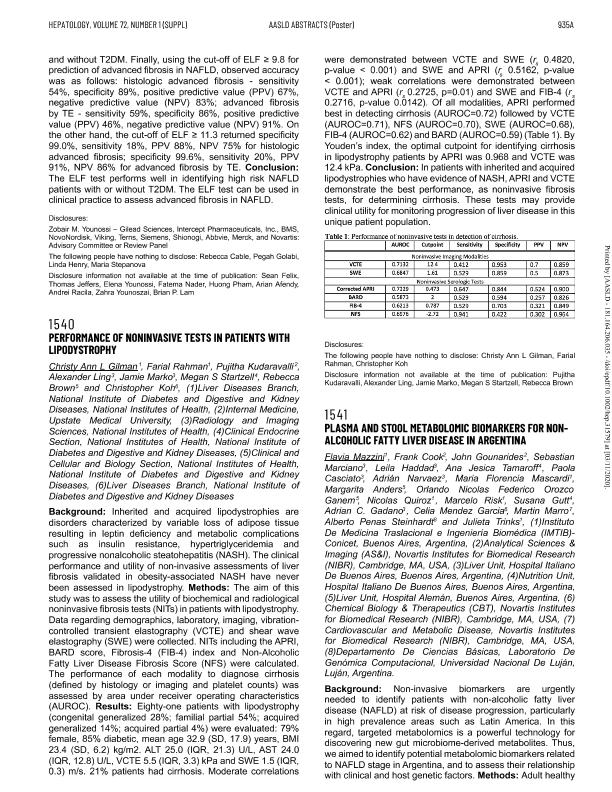Evento
Plasma and stool metabolomic biomarkers of non-alcoholic fatty liver disease in Argentina
Mazzini, Flavia Noelia ; Cook, Frank; Gounarides, John; Marciano, Sebastian; Haddad, Leila; Tamaroff, Ana Jesica; Casciato, Paola
; Cook, Frank; Gounarides, John; Marciano, Sebastian; Haddad, Leila; Tamaroff, Ana Jesica; Casciato, Paola ; Narvaez, Adriana Haydée; Mascardi, María Florencia
; Narvaez, Adriana Haydée; Mascardi, María Florencia ; Anders, Margarita; Orozco, Federico; Quiroz, Nicolas; Risk, Marcelo
; Anders, Margarita; Orozco, Federico; Quiroz, Nicolas; Risk, Marcelo ; Gutt, Susana; Gadano, Adrián Carlos; Mendez Garcia, Celia; Marro, Martin; Penas Steinhardt, Alberto
; Gutt, Susana; Gadano, Adrián Carlos; Mendez Garcia, Celia; Marro, Martin; Penas Steinhardt, Alberto ; Trinks, Julieta
; Trinks, Julieta
 ; Cook, Frank; Gounarides, John; Marciano, Sebastian; Haddad, Leila; Tamaroff, Ana Jesica; Casciato, Paola
; Cook, Frank; Gounarides, John; Marciano, Sebastian; Haddad, Leila; Tamaroff, Ana Jesica; Casciato, Paola ; Narvaez, Adriana Haydée; Mascardi, María Florencia
; Narvaez, Adriana Haydée; Mascardi, María Florencia ; Anders, Margarita; Orozco, Federico; Quiroz, Nicolas; Risk, Marcelo
; Anders, Margarita; Orozco, Federico; Quiroz, Nicolas; Risk, Marcelo ; Gutt, Susana; Gadano, Adrián Carlos; Mendez Garcia, Celia; Marro, Martin; Penas Steinhardt, Alberto
; Gutt, Susana; Gadano, Adrián Carlos; Mendez Garcia, Celia; Marro, Martin; Penas Steinhardt, Alberto ; Trinks, Julieta
; Trinks, Julieta
Tipo del evento:
Reunión
Nombre del evento:
The Liver Meeting Digital Experience
Fecha del evento:
13/11/2020
Institución Organizadora:
American Association for the Study of the Liver Disease;
Título de la revista:
Hepatology
Editorial:
Wiley
Idioma:
Inglés
Clasificación temática:
Resumen
Background: Non-invasive biomarkers are urgently needed to identify patients with non-alcoholic fatty liver disease (NAFLD) at risk of disease progression, particularly in high prevalence areas such as Latin America. In this regard, targeted metabolomics is a powerful technology for discovering new gut microbiome-derived metabolites. Thus, we aimed to identify potential metabolomic biomarkers related to NAFLD stage in Argentina, and to assess their relationship with clinical and host genetic factors. Methods: Adult healthy volunteers (HV) and biopsy-proven simple steatosis (SS) or non-alcoholic steatohepatitis (NASH) patients were recruited. Demographic, clinical and food frequency consumption data, as well as plasma and stool samples were collected. SNP rs738409 (PNPLA3 gene) was determined in all volunteers. HPLC and flow injection analysis with MS/MS in tandem was applied for metabolomic studies using the MxP Quant 500 Kit (Biocrates Life Sciences AG, Austria). Significantly different metabolites among groups were identified with MetaboAnalyst v4.0. Bivariate and multivariate analyses were used to identify variables that were independently related to NAFLD stage. Forward stepwise logistic regression models were constructed to design the best feature combination that could distinguish between study groups. Receiver Operating Characteristic (ROC) curves were used to evaluate models? accuracy.Results: 19 HV, 12 SS and 22 NASH patients were recruited. Diet was similar between groups. The concentration of 33 out of 424 detected metabolites (25 in plasma and 8 in stool) was significantly different among study groups. Levels of triglycerides (TG) were higher among NAFLD patients, whereas levels of phosphatidylcholines (PC) and lysoPC were higher among HV. The PNPLA3 risk genotype for NAFLD and NASH (GG) was related to higher plasma levels of eicosenoic acid FA(20:1) (p<0.001). Plasma metabolites showed a higher accuracy for diagnosis of NAFLD and NASH when compared to stool metabolites (Table 1). Body mass index (BMI) and plasma levels of PC aa C24:0, FA(20:1) and TG(16:1_34:1) showed high accuracy for diagnosis of NAFLD; whereas the best AUROC for discriminating NASH from SS was that of plasma levels of PC aa C24:0 and PC ae C40:1 (Table 1).Conclusions: Gut microbiome-derived metabolomic biomarkers were identified in plasma and stool, but plasma metabolites were better diagnostic biomarkers of NAFLD and NASH in Argentina. Further validation studies are needed.
Palabras clave:
MICROBIOME
,
NAFLD
,
METABOLITES
,
ARGENTINA
Archivos asociados
Licencia
Identificadores
Colecciones
Eventos (IMTIB)
Eventos de INSTITUTO DE MEDICINA TRASLACIONAL E INGENIERIA BIOMEDICA
Eventos de INSTITUTO DE MEDICINA TRASLACIONAL E INGENIERIA BIOMEDICA
Citación
Plasma and stool metabolomic biomarkers of non-alcoholic fatty liver disease in Argentina; The Liver Meeting Digital Experience; Estados Unidos; 2020; 1-4
Compartir



